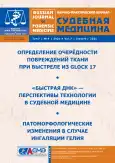Determination of the order of damage to a cotton cloth moistened with water when fired from a Glock 17 pistol
- Authors: Stepanov S.A.1, Krupin K.N.1, Globa I.V.1, Maksimov A.V.2, Kislov M.A.3
-
Affiliations:
- I.M.Sechenov First Moscow State Medical University (Sechenov University)
- Moscow Regional Research and Clinical Institute
- I.M. Sechenov First Moscow State Medical University (Sechenov University)
- Issue: Vol 7, No 4 (2021)
- Pages: 5-12
- Section: Original study articles
- URL: https://journals.rcsi.science/2411-8729/article/view/122400
- DOI: https://doi.org/10.17816/fm667
- ID: 122400
Cite item
Full Text
Abstract
BACKGROUND: To determine the order of the shot from a firearm, the presence of soot deposits and additional factors of the shot on the surface of the fabric is investigated. These signs were detected and tested on dry targets, but not studied on a wet target. There is no data in the available literature that allows determining the order of a shot on a water-soaked target.
AIMS: To identify morphological differences between gunshot wounds of dry and water-soaked tissue.
MATERIAL AND METHODS: For the experiment, a target object made of cotton calico was used; a Glock 17 pistol; 9×19 Parabellum cartridges. There were two groups of targets ― moistened with running water from a spray gun and dry. After impregnation, the fabric was hung in a vertical position on a thick cardboard substrate, and then a shot was fired. The firearm (Glock 17) was fixed on the frame, the muzzle end was directed towards the target at an angle of 90º. Shots were fired from a distance of 5 cm, 10 cm, 20 cm and further in increments of 10 cm to 100 cm inclusive. At each distance, 10 shots were fired, from which 3 targets were selected that had the most pronounced morphological changes: thermally altered fibers on the front surface of the target, along the edge of the gunshot injury, along the depth of penetration of the wiping belt. After that, the barrel of the firearm was cleaned. The study of the affected targets was carried out using a Leica M125 stereomicroscope. The results obtained during the experiment were entered into the MS Excel table where statistical processing was performed. A conditional probability was calculated for each feature. The diagnostic coefficient (DC) was calculated, and the Kulbak formula was used to assess the informativeness of the selected features.
RESULTS: It was revealed that signs of thermal action and the deposition of soot on the front side of the target are found on dry targets. Thermally altered filaments were not detected on wet targets, and the products of the shot penetrate the inter-fiber space. The thermal effect is manifested by the formation of flask-like and hemp-like endings of the fibers of the threads along the edge of the gunshot injury.
CONCLUSION: The detection of signs of thermal exposure, as well as the deposition of soot only on the front surface of the target, suggests that the shot was fired into a dry cloth. Penetration of the products forming the metallization belt into the inter-fiber space, as well as the absence of thermally altered threads, is characteristic of gunshot damage to wet targets.
Described changes in the protocol for registration of morphological lesions in the presence of an expert. The results of this study provide a better situational expertise.
Keywords
Full Text
##article.viewOnOriginalSite##About the authors
Sergey A. Stepanov
I.M.Sechenov First Moscow State Medical University (Sechenov University)
Email: stepanov_s_a@staff.sechenov.ru
ORCID iD: 0000-0001-7888-3104
SPIN-code: 9673-3580
Russian Federation, 61/2 Shepkina street, Moscow, 129110
Konstantin N. Krupin
I.M.Sechenov First Moscow State Medical University (Sechenov University)
Email: krupin@1msmu.ru
ORCID iD: 0000-0001-6999-8524
SPIN-code: 1761-8559
MD, Cand. Sci. (Med.)
Russian Federation, 61/2 Shepkina street, Moscow, 129110Irina V. Globa
I.M.Sechenov First Moscow State Medical University (Sechenov University)
Email: globa_i_v@staff.sechenov.ru
ORCID iD: 0000-0002-7185-4324
SPIN-code: 3976-6782
Russian Federation, 61/2 Shepkina street, Moscow, 129110
Aleksandr V. Maksimov
Moscow Regional Research and Clinical Institute
Email: maksimov@sudmedmo.ru
ORCID iD: 0000-0003-1936-4448
SPIN-code: 3134-8457
Scopus Author ID: 848828
MD, Dr. Sci. (Med.)
Russian Federation, 61/2 Shepkina street, Moscow, 129110Maxim A. Kislov
I.M. Sechenov First Moscow State Medical University (Sechenov University)
Author for correspondence.
Email: smedik@gmail.com
ORCID iD: 0000-0002-9303-7640
SPIN-code: 3620-8930
MD, Dr. Sci. (Med.), Professor
Russian Federation, 61/2 Shepkina street, Moscow, 129110References
- The Global Burden of Disease 2016 Injury Collaborators; Naghavi M, Marczak LB, Kutz M, et al. Global mortality from firearms, 1990–2016. JAMA. 2018;320(8):792–814. doi: 10.1001/jama.2018.10060
- Brief description of the state of crime in the Russian Federation for January-December 2020. (In Russ). Available from: https://xn--b1aew.xn--p1ai/reports/item/22678184. Accessed: 06.10.2021.
- Kislov MA, Chauhan M, Leonov SV, Pigolkin YuI. Forensic medical characteristics of firearm exit wounds in cases with armour protection. Legal Med. 2022;54:102002. doi: 10.1016/j.legalmed.2021.102002
- Kislov M, Chauhan M, Zakharov S, et al. Computer assisted three-dimensional reconstruction of scene in firearm homicide. Med Leg J. 2021;89(3):193–198. doi: 10.1177/00258172211018359
- Yen K, Thali MJ, Kneubuehl BP, et al. Blood-spatter patterns: hands hold clues for the forensic reconstruction of the sequence of events. Am J Forensic Med Pathol. 2003;24(2):132–140. doi: 10.1097/01.paf.0000065164.92878.2f
- Viel G, Gehl A, Sperhake JP. Intersecting fractures of the skull and gunshot wounds. Case report and literature review. Forensic Sci Med Pathol. 2009;5(1):22–27. doi: 10.1007/s12024-008-9062-8
- Kustanovich SD. Investigation of clothing damage in forensic medical practice: a practical guide. Moscow: Meditsina; 1965. 217 p. (In Russ).
- Korovkin DS, Isakov VD, Sukharev AG. Samples of damage descriptions on clothing: a methodological guide. Saint Petersburg; 2011. 250 p. (In Russ).
- Odintsovo OI, Krotova MN, Smirnova SV. Fundamentals of textile materials science: text of lectures. Ivanovo; 2009. 64 p. (In Russ).
- GOST R 56561-2015. National standard of the Russian Federation. Textiles. Composition testing. Identification of fibres. (In Russ). Available from: https://docs.cntd.ru/document/1200124125. Accessed: 06.10.2021.
- Öztürk MK, Nergis B, Candan C. A study of wicking properties of cotton-acrylic yarns and knitted fabrics. Textile Res J. 2011;81(3):324–328. doi: 10.1177/0040517510383611
- Boncevitch DN. Capillary and wicking of modified and tradition suture matirial. Health and Ecology. 2007;(3):135–140. (In Russ).
Supplementary files












